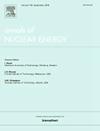High-dimensional multi-objective shielding optimization method based on multi-parameter shielding calculation agent model
IF 1.9
3区 工程技术
Q1 NUCLEAR SCIENCE & TECHNOLOGY
引用次数: 0
Abstract
The design of complex reactor shielding structures requires consideration of neutron and photon radiation levels in various regions, as well as trade-offs in weight, volume, and cost, leading to a substantial increase in shielding calculation parameters and optimization objectives. This study introduces a high-dimensional multi-objective shielding optimization method based on a multi-parameter shielding calculation surrogate model, with significant improvements to the FCNN-NSGAIII shielding optimization method which integrates a neural network with a genetic algorithm. For the optimization of complex reactor shielding structures under diverse source item energy spectra, the multi-parameter surrogate model achieves a prediction error reduction of an order of magnitude to 3.65% compared to traditional neural networks. Furthermore, the k_NSGAIII optimization algorithm, enhanced with a knee-point strategy, demonstrates a greater relative set coverage indicator than the NSGAIII algorithm, indicating its ability to identify superior shielding design schemes.
求助全文
约1分钟内获得全文
求助全文
来源期刊

Annals of Nuclear Energy
工程技术-核科学技术
CiteScore
4.30
自引率
21.10%
发文量
632
审稿时长
7.3 months
期刊介绍:
Annals of Nuclear Energy provides an international medium for the communication of original research, ideas and developments in all areas of the field of nuclear energy science and technology. Its scope embraces nuclear fuel reserves, fuel cycles and cost, materials, processing, system and component technology (fission only), design and optimization, direct conversion of nuclear energy sources, environmental control, reactor physics, heat transfer and fluid dynamics, structural analysis, fuel management, future developments, nuclear fuel and safety, nuclear aerosol, neutron physics, computer technology (both software and hardware), risk assessment, radioactive waste disposal and reactor thermal hydraulics. Papers submitted to Annals need to demonstrate a clear link to nuclear power generation/nuclear engineering. Papers which deal with pure nuclear physics, pure health physics, imaging, or attenuation and shielding properties of concretes and various geological materials are not within the scope of the journal. Also, papers that deal with policy or economics are not within the scope of the journal.
 求助内容:
求助内容: 应助结果提醒方式:
应助结果提醒方式:


